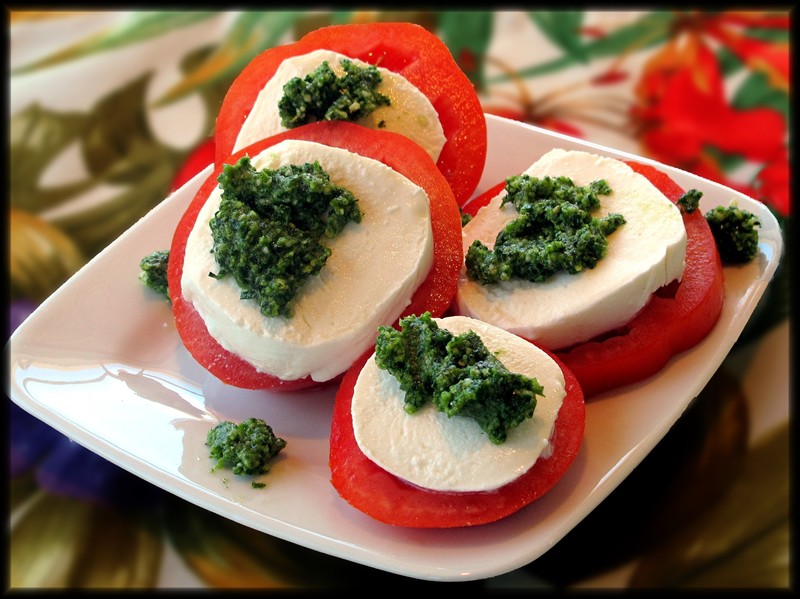I recently learned that for all the times I’ve made pesto at the end of the summer, I’ve done it incorrectly. My first mistake was to use leaves from the solitary basil plant in my garden, the one that grew into a massive shrub during the course of the season. One whiff and I know now that these are undesirable licorice-scented older leaves. I should have sowed dozens of plants instead, and harvested their leaves when they sported only a few. My second mistake was my technique: food processors or blenders will shred the leaves, while a mortar and pestle will release basil’s essential oils and create a smoother texture.
For those of you not familiar with pesto, let me back up a bit. This Italian sauce is made from just the right balance of basil, olive oil, pine nuts, cheese and salt. Its vivid green color, creamy texture and bright flavor notes are perfect with fresh pasta or gnocchi, as well as grilled chicken or fish. The name comes from pestare (to pound), which is how the sauce is traditionally made: the ingredients are ground together in a mortar and pestle (and we’re talking about a much larger version than that tiny white bowl many of us use to grind spices).
Purists insist that basil genovese, also known as sweet basil (Ocimum basilicum), is the only type that belongs in traditional pesto. The leaves should be pale green and quite young, hence the strategy of planting seeds or many seedlings and collecting leaves while they’re tender. Basil, a member of the mint family, has more than different varieties; if you want your pesto to reflect a slightly different flavor signature, you can try substituting lemon basil or clove-flavored opal basil.
As with any dish that calls for extra virgin olive oil, it’s a must to choose high-quality oil. To avoid overpowering the subtle flavors in pesto, don’t select oils that are too fruity or very bold. Coarse sea salt is preferable to kosher salt, as the grains will help in the grinding process. You’ll find recipes will call for either sheep’s-milk pecorino or aged Parmesan or both for the cheese. For authentic flavor, the more expensive imported Italian (not Chinese) pine nuts are a better choice.
Now that you’ve assembled all the ingredients, you’re ready to make your pesto. If you have a mortar and pestle large enough (at least six inches in diameter) try it instead of the blender or food processor. Regardless of your chosen tools, the sequence of ingredients is the same: garlic; pine nuts; basil; salt; a stream of olive oil; and cheese. Keep blending until you have a smooth paste.
Although pesto is considered sauce, its texture is usually fairly thick (as in the photo). If you prefer, you can thin the consistency by adding more olive oil. And, if you’re serving it over pasta, I find a bit of melted butter helps pesto better cling to the shapes or strands.
Once you have a batch of pesto, the options are limitless: spread it on toasted bread rounds for savory bruschetta, drop a dollop into your tomato sauce or soup, toss it with roasted fingerling potatoes or stir some into your meatball mix. You can also use pesto as the base of a cream sauce by whisking it into a mixture of melted butter and heavy cream – wonderful over mushroom ravioli.
Other variations include subtituting different leafy greens for the basil, as in parsley, watercress or arugula pesto. Another change is to add sun-dried tomatoes or olives to the standard recipe – more flavors from the Mediterranean region that gave birth to pesto. You’ll also find recipes with replacements for the pine nuts, such as walnuts, pistachios and hazelnuts.
No matter how you make your pesto, just remember not to wait until the end of summer to pick your basil.
Basic Pesto
2 cloves garlic
1/4 C pine nuts
4 C basil leaves
1/2 t sea salt
1/3 C olive oil
1/2 C Parmesan cheese
Place the peeled garlic cloves and pine nuts in a mortar and grind with a pestle until combined. Add the basil leaves and salt; continue to grind, turning the bowl often. Once the leaves have broken down, pour in the olive oil and continue mixing until smooth. Stir in the cheese until combined and serve over pasta. Note: if preparing pesto in a blender or food processor, add ingredients in the same order, stopping often to push down contents with a wooden spoon.
Pesto Cream Sauce
1 T butter
1 C pesto
1/2 C cream
Melt butter in small saucepan over low heat. Add pesto and cream, whisking until smooth. Serve over pasta, grilled chicken or fish.
Sun-dried Tomato Pesto
1 peeled garlic clove
2 T pine nuts
2 T fresh basil leaves
1/2 C sun-dried tomatoes*
1/4 t salt
3 T olive oil
2 T Parmesan cheese
Combine ingredients in a blender or food processor or grind together with a mortar and pestle. *Note: if using oil-packed sun-dried tomatoes, drain completely before adding; discard oil.
Arugula Pesto
3 peeled garlic cloves
2 T pine nuts
1/4 t salt
4 C arugula
juice of 1 lemon
1/3 C olive oil
1/4 C Pecorino Romano cheese
Place garlic, pine nuts, and salt in the bowl of a food processor; pulse until roughly chopped. Add arugula and lemon juice; purée until smooth. With the machine running, pour olive oil in a slow, steady stream. Stir in cheese and serve.




















































